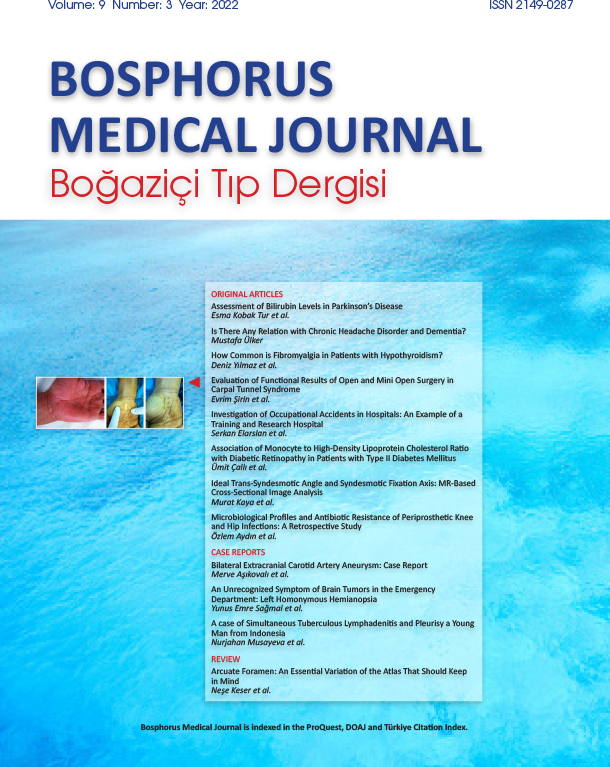Volume: 11 Issue: 1 - 2024
| FRONT MATTERS | |
| 1. | Front Matter Pages I - X |
| ORIGINAL RESEARCH | |
| 2. | Retrospective Analysis of the Potential Effects of CHA2DS2-VASc and HAS-BLED Scores on Treatment Choices for Atrial Fibrillation Patients in a Stroke Center Işıl Kalyoncu Aslan, Ceren Erkalaycı, Leyla Ramazanoğlu, Kadriye Güleda Keskin doi: 10.14744/bmj.2024.12599 Pages 1 - 6 INTRODUCTION: Current information lacks an algorithm that directs us to a specific anticoagulation treatment option for patients with atrial fibrillation (AF), except in certain situations. Our aim was to evaluate the potential relationship between different oral anticoagulant choices and the CHA₂DS₂-VASc (congestive heart failure, hypertension, age, diabetes mellitus, stroke, vascular disease, age, sex category) and HAS-BLED (hypertension, abnormal renal and liver function, stroke, bleeding, labile international normalized ratio (INR), elderly, drugs or alcohol) scores of patients, and their treatment compliance. METHODS: We retrospectively documented the patients' age, gender, CHA₂DS₂-VASc, and HAS-BLED scores to assess our preference for oral anticoagulants in AF patients. Two hundred patients with AF were divided into two main groups: those with newly diagnosed AF and those with an established diagnosis of AF. The treatment compliance of patients with AF was documented, and the treatment choices at discharge for patients in both groups were compared based on age, gender, and the two scores. Scores were divided into three main groups for easy comparison. The level of statistical significance was accepted as p<0.05. RESULTS: Ninety-nine of the two hundred patients had a stroke and were diagnosed with AF, while 101 patients had an already established diagnosis of AF and experienced a stroke while using OAC or NOAC on a regular or irregular basis. Warfarin sodium (59.6%) was most often preferred at the discharge of patients, and apixaban (22.2%) was the most preferred NOAC. The daily dosage number of NOACs doesnt make any difference in terms of compliance. The irregular usage of warfarin sodium constituted the vast majority in the irregular group. No statistically significant difference was found between the two scoring system groups and the treatment choices in both groups. DISCUSSION AND CONCLUSION: Patients should be evaluated individually when choosing an oral anticoagulant, with the intention to prioritize education aimed at the correct use of the drug rather than the selection of an appropriate drug. |
| 3. | Analysis of Blood Culture Results and Antibiotic Sensitivities in Adult Patients Applying to a Training and Research Hospital in Istanbul Fatma Sarı Doğan, Ebru Ünal Akoğlu, Tuba Cimilli Öztürk doi: 10.14744/bmj.2024.72623 Pages 7 - 14 INTRODUCTION: Sepsis is a life-threatening condition caused by microorganisms entering the bloodstream and spreading very rapidly. In sepsis guidelines, starting early antibiotic treatment is one of the main steps of treatment. Therefore, it is necessary to know the antibiotics to which the agents are susceptible. Our study aimed to determine the antibiotic susceptibility and resistance of microorganisms grown in blood cultures obtained from patients admitted to the emergency department of our hospital and treated in the inpatient ward or intensive care unit. METHODS: The blood cultures in our hospital in the 1-year period between 2018 and 2019 were analyzed retrospectively. The age and gender of the patients from whom the blood cultures were obtained, the microorganisms grown, and their antibiotic susceptibility/resistance were recorded and analyzed statistically. RESULTS: A total of 1232 blood cultures were included in the study, and growth was observed in 182 blood cultures. Staphylococcus epidermidis, Staphylococcus aureus, Escherichia coli, Enterococcus faecalis, and Acinetobacter baumannii were isolated most frequently. The antibiotics to which staphylococci were most susceptible were trimethoprim-sulfamethoxazole, vancomycin, and gentamicin, while the highest resistance was found to ertapenem and penicillin. Methicillin-resistant coagulase-negative Staphylococcus (MRCNS) was 54.1%, and methicillin-resistant Staphylococcus aureus (MRSA) was 28%. For Escherichia coli, ceftriaxone resistance was 72%, ciprofloxacin resistance was 68.4%, while 82.4% were susceptible to gentamicin, and 100% to carbapenems. Multidrug resistance was 61%. DISCUSSION AND CONCLUSION: In our study, Staphylococcus epidermidis, Staphylococcus aureus, Escherichia coli, Enterococcus faecalis, and Acinetobacter baumannii were isolated most frequently from blood cultures, respectively. Escherichia coli was highly resistant to ciprofloxacin and ceftriaxone but susceptible to aminoglycosides and carbapenems. We also found that multidrug resistance was quite high. Early initiation of appropriate antibiotics in the treatment of sepsis and bacteremia reduces mortality. Therefore, it is important to determine the most frequently isolated pathogens and their antibiotic susceptibility and resistance status. |
| 4. | Factors Affecting Length of Stay in a Stroke Unit After Intravenous Thrombolytic Therapy: A Retrospective Study Şerife Kelle Dikbaş, Işıl Kalyoncu Aslan doi: 10.14744/bmj.2024.37450 Pages 15 - 22 INTRODUCTION: This study aimed to examine the hospitalization duration in the stroke unit after IV thrombolytic therapy in acute ischemic stroke and the affecting factors. METHODS: The research was designed as a retrospective study. From 334 patients admitted to a state hospital in Istanbul's stroke unit with a stroke diagnosis, 152 patients who received IV thrombolytic therapy constituted the study's sample. The hospital registry system, nurse observation notes, and patient files in the hospital archive were examined by the researcher to access the patients' socio-demographic and clinical data. Pearson correlation analysis was used to analyze the relationships between parameters conforming to a normal distribution, along with descriptive statistical methods. RESULTS: The mean length of stay in the stroke unit was 3.2±3 days(2). Complications developed in 44.1% (67) of the patients during hospitalization. Among these complications, respiratory-related complications were the highest at 19.5% (13), followed by cerebral hemorrhage and cerebral edema at 18% (12). The most common reason for transferring patients was routine transfer at 82.3% (125). A statistically significant positive correlation was found (r=0.261; p<0.05) between the duration of stay in the stroke unit and the severity of the stroke. A positive (r=0.026; p<0.05) relationship was found between the stroke unit stay duration and the patient's age, and a negative relationship (r=-0.220; p<0.05) was found with the Glasgow Coma Scale before IV thrombolytic therapy. DISCUSSION AND CONCLUSION: Short hospital stays and low mortality rates demonstrate the benefit of close observation of IV tPA patients. Complication development during stroke unit stay, stroke severity, age, as well as history of smoking and alcohol use in patients receiving IV thrombolytic therapy affect the length of hospital stay. |
| CASE REPORT | |
| 5. | Effective Percutaneous Treatment of Type 2 Endoleak via Target Artery Punction Under the Guidance of Fluoroscopy and Ultrasound Abdulrahman Naser, Khagani Isgandarov, Ahmet Kemal Fırat, Müslüm Şahin, Oya Güven doi: 10.14744/bmj.2024.45822 Pages 23 - 26 Endoleak is a significant complication of endovascular aneurysm repair (EVAR), which can precipitate aneurysm rupture. In addition to interventional radiology clinics, endoleaks are treated by interventional cardiologists and cardiovascular surgeons as well. In this paper, we present a successful repair of a type II endoleak by a cardiology team. A 65-year-old male patient was treated with emergency EVAR due to a ruptured left common iliac artery aneurysm (CIA). After the procedure, control computed tomographic angiography (CTA) revealed a type II endoleak supplied by the left internal iliac artery, and coil embolization was applied. Percutaneous coil and Onyx embolization of endoleak can be safely performed in cardiology clinics by direct puncture of the target vessel under fluoroscopy and ultrasound guidance. |
| 6. | Sensorimotor Radiculopathy Caused by Intracranial Hypertension Treated with CSF Diversion: Case Report Deniz Şirinoğlu, Ozan Başkurt, Idris Avcı, Mehmet Volkan Aydın doi: 10.14744/bmj.2024.20438 Pages 27 - 30 Idiopathic intracranial hypertension or pseudotumor cerebri is defined as increased intracranial pressure without radiologic findings of intracranial masses or obstructive hydrocephalus. Typical symptoms include headache, nausea, visual disturbances, and papilledema. In some cases, radiculopathy may present as acral paresthesias, back pain, and radicular pain. We present here an extremely rare case of sensorimotor radiculopathy caused by idiopathic intracranial hypertension; manifested by drop foot and treated with cerebrospinal fluid diversion. |




















